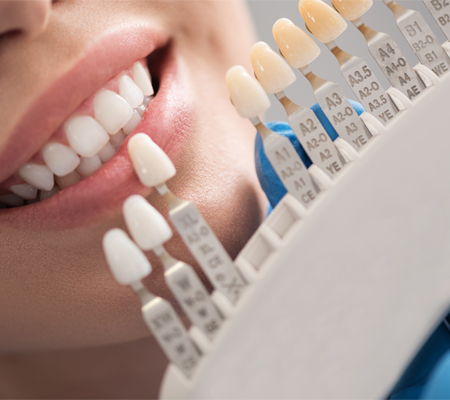TEETH WHITENING
Teeth Whitening (Bleaching)
 Nowadays, teeth whitening applying is often preferred with the desire to have an aesthetic smile. The colors of the teeth vary according to the inner and outer colors on the surface. Discoloration may occur on the inside due to many reasons, such as tooth decay, root canal treatment applying, defects in tooth enamel and trauma. External discoloration, on the other hand, may occur for reasons such as plaque and tartar accumulation, inadequate oral hygiene, consumption of dyestuff foods such as tea/coffee, and tobacco use.
Nowadays, teeth whitening applying is often preferred with the desire to have an aesthetic smile. The colors of the teeth vary according to the inner and outer colors on the surface. Discoloration may occur on the inside due to many reasons, such as tooth decay, root canal treatment applying, defects in tooth enamel and trauma. External discoloration, on the other hand, may occur for reasons such as plaque and tartar accumulation, inadequate oral hygiene, consumption of dyestuff foods such as tea/coffee, and tobacco use.In case of color changes that cannot be eliminated by tartar cleaning and polishing, the tooth color can be changed by bleaching, also called bleaching. According to clinical studies, teeth whitening procedures are reliable and effective methods for correcting the appearance of discolored teeth. In general, office-type and home-type bleaching procedures are applied. The most appropriate method is determined according to the patient, and combined treatments can be applied if necessary.
Office-type bleaching process:
High-concentration whitening products are applied by a dentist in a clinical setting. By applying a protective barrier to the gums with a cheek and lip extractor, it is ensured that the whitening material affects only the teeth. It is expected that the whitening material, which has a chemical effect or shows its effect with laser beams, will be applied to the tooth surface and show its effect. After each applying, the tooth color is checked and bleaching material is applied again if necessary. Although a single session lasts 15 minutes, the desired whiteness can be achieved on many teeth with 3 consecutive sessions on the same day.
The home-type bleaching process:
After the personal plaque is prepared after the measurement taken from the patient, the treatment is carried out by checking the physician in the home bleaching process, which is performed by applying low-concentration bleaching material to the plaque by the patient. The whitening material is usually applied for an average of 1-2 weeks with a duration of 2 to 4 hours at night. If the whitening material is applied more than necessary due to the desire to perform the whitening process quickly, sensitivity may occur in the teeth.
Can products such as bleaching paste/ baking soda be used?
The unconscious and excessive use of whitening pastes, tapes and mouthwashes, called over-the-counter products, can cause irreversible damage to tooth enamel due to their corrosive content. Before using these products, the dentist should definitely be consulted and the frequency of use should be decided according to the needs. Acidic products such as baking soda, lemon, apple cider vinegar should never be used, it should be remembered that they can damage tooth enamel in a short time, leading to very serious sensitivity and linear coloring.
Is there any pain felt during the whitening process?
No pain is felt and anesthesia is not required. Rarely, sensitivity may occur in patients during clinical practice. The duration and frequency of this temporary condition vary with each patient. In the office type whitening process, which we perform in the form of short 15-minute sessions, patients are constantly asked how they feel, and if hypersensitivity occurs, the whitening process is terminated.
Is there any harm in the bleaching process?
The products used do not cause any damage to the tooth enamel. Sensitivity may occur after bleaching in some patients. In this temporary condition, patients are advised to use a sensitivity-relieving paste and are asked to avoid excessively hot and cold foods for a few days. In studies conducted on the formation of sensitivity after bleaching, it has been found that usually home-type and office-type bleaching methods show similar results.
What are the things to be considered after the bleaching process?
Excessive hot and extremely cold foods and drinks should be avoided for the first few days in order to minimize the occurrence of sensitivity. Tea, coffee, cola, cigarettes, tomatoes, chocolate, cherries, tomato paste, such as coloring foods should be avoided for at least 3-4 days after bleaching for 2 weeks, provided that. Avoiding coloring foods affects the permanence of the whitening process. Attention should be paid to oral hygiene, teeth should be carefully brushed 2 times a day.
How long is the permanence of the whitening process?
After whitening, it is observed that the tooth color returns to its former state over time depending on the person's eating style and habits. This period varies with each patient. If necessary, the whitening process can be repeated every 6-12 months under the control of a dentist before the teeth return to their previous state. As a result of the checks made every 6 months, bleaching is ensured to last longer, the duration of the second bleaching process is shortened, more aesthetic and economic results are obtained.


 Kocatepe Mah. 33. Sk. No:5/A Bayrampaşa - İstanbul
Kocatepe Mah. 33. Sk. No:5/A Bayrampaşa - İstanbul 







